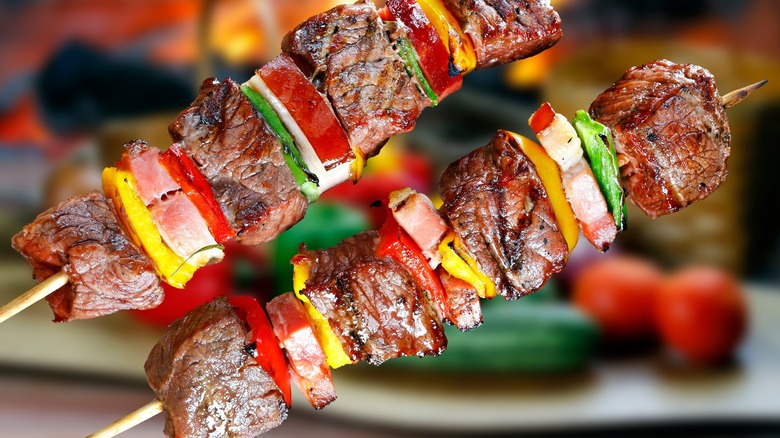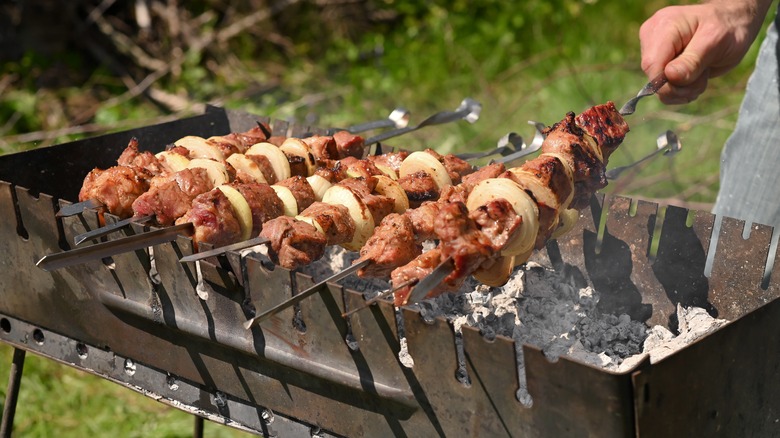The Ancient Origins Of The Iconic Shish Kebab
Shish kebabs present an opportunity for endless combinations of meat and vegetables grilled to perfection. Since they're so easy to throw together and so flexible in choice of ingredients, it's not surprising that they've been around for a long, long time.
Decades? Centuries? Try millennia. Thanks to archaeological evidence uncovered in what's now central China, we know that people have been eating skewered meat for at least 2,000 years. Although it's spread far and wide — starting with the nomadic tribes of Central Asia and reaching all the way through Turkey and into the royal courts of Western Europe — the basic idea has remained pretty much the same.
There's something very poignant about the idea that the next time you fire up the grill and enjoy some kebabs, you're sharing a connection with people who lived thousands of years ago. Neat, right? Let's talk about just how far back the idea of skewered meat and the shish kebab goes.
Archaeological evidence puts the kebab in ancient China
In 2022, a joint team of archaeologists working in China's Changle Cemetery published their findings in the journal Heritage Science. They were looking at the archaeological remains of the era of the cemetery's use, which spanned from 202 BC to 220 CE, and it's fascinating stuff. In addition to finding evidence of baking — which included millet cakes — they also found a kebab which was made from sheep or goat meat. The discovery marked the oldest evidence of mutton as a Chinese foodstuff to date, which is pretty wild.
The study also says that there is additional evidence that skewered meat was popular throughout the Han dynasty, which is the period that overlaps with the cemetery's use. How do we know? In addition to having found skewers and grills, kebabs were such a big deal that they've been found immortalized in the artwork of Han tombs.
Researchers say it's highly likely that the Han adopted the kebab from the Hu, who were a largely nomadic people who lived in the same area and are thought to have shared a number of practices in their food culture, including roasting meat, baking, and the widespread use of cereal grains. And it makes sense: The area isn't too far from what would become the Silk Road, a 4,000-mile trade route that linked what's now Shanghai to the Mediterranean.
Skewered meat became a shish kebab as the idea traveled West
The shish kebab is one specific kind of kebab, and the word comes from the Turkish term şiş kebap that translates to "skewered meat." (Other types of kebabs include the shashlik from the Caucasus, and the Doner kebab, which is another Turkish version of the idea that uses shaved meat instead of chunks. Also included in the family are versions that use ground meat in Pakistan and India, Japan's yakitori cooking, Indonesia's satay, and Nigeria's suya.)
It's unclear just what happened when, but by the time it became a popular food in Turkey, the shish kebab was almost always a lamb or mutton-based dish. After traveling west, shish kebabs had cemented their popularity by the rise of the Ottoman Empire, which established itself at the beginning of the 14th century. From there, it went even farther west — and underwent a major change.
It was the Greeks that added vegetables to the largely meat-only meal, and it's that one that made it to the New World to become the massive favorite that it is today. Shish kebab has always been popular, even among the rich and famous. In 2023, researchers from the University of Essex revealed that as they had been cataloging the 40,000 dishes that had been served to British royalty over the years, they'd found that one of the dishes served to King George III (at the turn of the 18th century) was Turkish kebabs.


